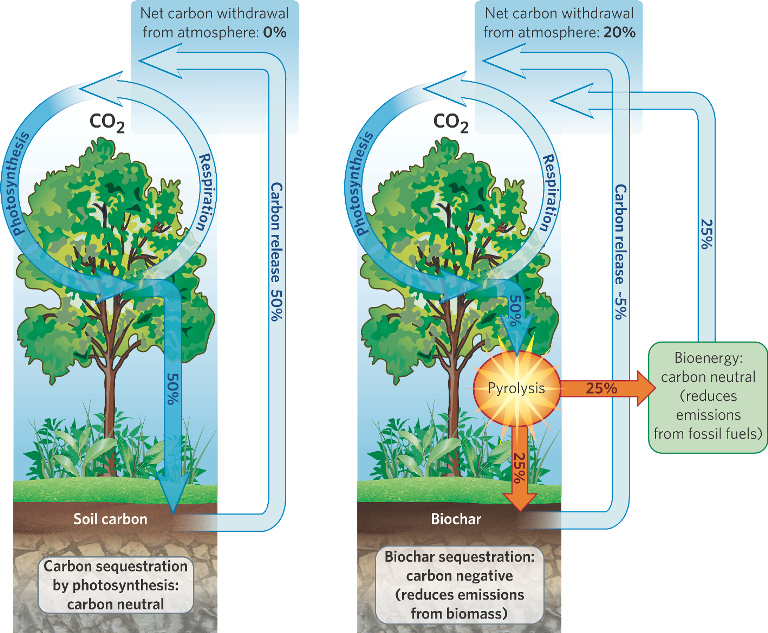Author: Rachel Smoker, Biofuelwatch
In 2012, Biofuelwatch published a report titled “Bioenergy with carbon capture and storage: Climate savior or dangerous hype?” We had long been working to reveal and oppose large scale industrial and commercial scale bioenergy in various forms ranging from ethanol refineries to soy and palm oil biodiesel to coal plants converting over to burn wood. We had argued that corn ethanol would drive biodiversity loss, cause food prices to rise and contribute to chronic hunger, while failing to reduce emissions, as it has in fact done. We argued that burning wood as a substitute for coal would create a new driver of deforestation, even as protecting forests and ecosystems was recognized as a “best line of defense” against climate change. We pointed out that large scale bioenergy was incompatible with the simultaneous push to quantify, commodify and protect land based carbon sinks and their “services” (often for the dubious purpose of providing offsets to polluters…). We highlighted the human rights impacts, as land grabs for bioenergy escalated in Africa and elsewhere. And we argued over and over that the carbon consequences of bioenergy were far from “climate friendly” or “carbon neutral,” a myth that has been perpetuated by industry proponents and even parroted by many naive environmentalists.
When we learned that BECCS was being advocated as an approach to “mitigation,” we turned our attention to providing a critique based on many of those, by now familiar, arguments. When BECCS spilled into the debates on climate geoengineering, we were outraged. Then even the supposedly scientific body, the IPCC released their Working Group III (Mitigation) Summary for Policymakers in April 2014, it stated that: “Mitigation scenarios reaching about 450 ppm CO2eq in 2100 typically involve temporary overshoot of atmospheric concentrations as do many scenarios reaching about 500-550 ppm CO2 eq in 2100. Depending on the level of the overshoot, overshoot scenarios typically rely on the availability and widespread deployment of BECCS and afforestation in the second half of the century. The availability and scale of these and other Carbon Dioxide Removal (CDR) technologies and methods are uncertain and CDR technologies and methods are, to varying degrees associated with challenges and risks (see Section SPM 4.2, high confidence).” While they acknowledge “uncertainties,” they nonetheless incorporate BECCS into models as if its feasibility and effectiveness is a given.
While they acknowledge “uncertainties,” they nonetheless incorporate BECCS into models as if its feasibility and effectiveness is a given.
In fact, “uncertainties” is an understatement. Over the years we have been making our arguments heard and fighting to oppose large scale bioenergy projects and policies, a burgeoning body of peer reviewed scientific literature has been published supporting and substantiating the concerns we raised, and public opinion has evolved and shifted. Witness for example how corn ethanol, the darling of big agribusiness, some farmers, the oil industry and many environmentalists – has fallen out of favor in public perception. Over the past few years the EPA has been lobbied by a diverse assortment of industry groups to repeal the ethanol mandate, and policymakers have supported that with introduction of legislation.
In Europe, policymakers have (at least) taken note of the evolving understanding of bioenergy, though that has not been reflected back on policy as of yet. There have been drawn out debates over indirect land use change and “sustainability standards” in particular, with the European Commission and Council suggesting that biofuel targets should be eliminated from the next climate and energy package (after 2020).
Nonetheless, avid proponents of BECCS hold fast to the simplistic claim that it can provide a “fix” for the climate, even permitting “overshoot” – allowing greenhouse gas concentrations to rise above what is indicated for long term stabilization based on the assumption that the excess can later be “cleaned up”.
In a recent reality check, scientists estimated what it would take to sequester 1 billion tonnes of carbon using BECCS based on switchgrass feedstock. Their findings showed a startling 218-990 million hectares of land would have to be converted to switchgrass (which is 14-65 times as much land as the US uses to grow corn for ethanol); also 17-79 million tonnes of fertiliser a year – which would be 75% of all global nitrogen fertiliser used at present; and 1.6-7.4 trillion cubic metres of water a year.
Even if such a BECCS-project was to actually sequester a billion tonnes of carbon a year, the authors point out that the nitrous oxide emissions from the extra fertilizer use alone would, over the course of a century ‘offset’ 75-310% of that sequestered CO2. In other words: Increased fertilizer use alone would likely mean that either of those projects would increase greenhouse gas emissions overall and thus make climate change even worse. That does not even include the vast carbon emissions from clearing trees, shrubs and grass from hundreds of millions of hectares of land, destroying large reservoirs of soil carbon, or the emissions from all the fossil fuels burned to transport and process switchgrass. Nor does it include emissions from producing the synthetic fertilizers.
BECCS advocates also adhere to the simplistic notion that all bioenergy (from corn ethanol to burning wood) is “carbon neutral.”
BECCS advocates also adhere to the simplistic notion that all bioenergy (from corn ethanol to burning wood) is “carbon neutral.” Therefore, it is argued, adding CCS further renders it “carbon negative”. The “carbon neutral” claim has been refuted time and time again in scientific literature. Timothy Searchinger was among the first to do so with a paper entitled “A Critical Climate Accounting Error“. Others have further elaborated on the carbon implications of various forms of bioenergy, from corn ethanol to crop residue cellulosic fuels to wood bioenergy. When full consideration is given, including impacts on soils, fertilizer use and both direct and indirect land use change, bioenergy processes are, in reality, far from “neutral”.
A case in point is wood bioenergy. Conversion of coal plants to burn wood, dedicated new-build wood burning power plants as well as combined heat and power and biomass boilers for heating are creating huge new demand for wood pellets. Wood burning is subsidized as renewable energy and also favored for use in dirty older coal plants that must meet new regulations on sulphur dioxide emissions.[1] Hence large coal plants such as DRAX in the UK are converting to burn wood pellets. In the UK, these are largely imported from the southeastern USA. While the energy industry claims to use only “wastes and residues”, those are clearly not abundantly available. Recent investigation of the largest pellet producer in the US, Enviva, revealed that they were sourcing wood from remaining pockets of endangered Atlantic coastal forests and then shipping them across the Atlantic to burn with coal.
Cutting trees to burn (or refine) for bioenergy can hardly be considered carbon neutral or climate friendly.[2] Though this would seem to be common sense, there are now many scientific studies showing that uncut forests (and their soils) store more carbon than those that are disturbed and harvested[3], and continue to do so as they grow older, storing far more than fast rotation industrial tree plantations. Even ignoring the impacts on forests, harvest and transportation and looking only at the emissions coming from smokestacks, wood releases around 50% more CO2 per megawatt of electricity generation than coal!
If bioenergy is not carbon neutral, then it simply cannot be rendered carbon negative by adding CCS, even if captured carbon were securely stored away (which we will see below, is unlikely).
So the enthusiasm for BECCS and continued “carbon negative” rhetoric seems a bit puzzling. Are proponents of BECCS just horrifically poor at math? Or is there some other motive behind the ongoing support for a technology that appears entirely nonsensical and lacking credibility? Perhaps BECCS supporters are scared stiff about the pace and scale of global climate change, understand that desperate measures are needed, and consider BECCS, in spite of shortcomings, to be “more benign” than other approaches such as sulphate particle injection into the stratosphere? That was certainly the overarching mood at the recent IASS conference on climate geoengineering in Potsdam, Germany.
Or perhaps there is something else going on? Many climate “solutions” that are being offered to us are in fact those that large and powerful corporations such as the oil companies are willing to engage. We have been hearing the term “clean coal” for decades now. Why the persistence?
Here is one possibility: according to an analysis commissioned by the U.S. Department of Energy (DOE) there are large amounts of oil lying around in the difficult to access depths of previously depleted oil wells. That oil could be accessed using “enhanced oil recovery”, which can be achieved by pumping compressed CO2 into those wells to force out the remaining difficult to access oil.[4] They project that at least 137 billion barrels of oil could potentially be extracted, 67 billion barrels of which could be economically recoverable at a price of $85 a barrel. That is three times the current U.S. proven reserves!
The National Energy Technology Laboratory “EOR Primer” states that “somewhere around 85 billion barrels of oil are recoverable using CO2 EOR, which currently is responsible for about 4 percent of U.S. oil production, displaying a long-term growth trend that stands in stark contrast to the long-term decline trend for U.S. oil production overall. Certainly, the volume of “stranded” oil left behind in U.S. reservoirs after conventional primary and second recovery techniques is massive—as much as two-thirds of all the oil discovered in the United States resides in this category.”[5]
In short, with oil reserves becoming more and more difficult to access and extract, EOR is becoming more and more attractive.
The US Chamber of Commerce recognizing this, states: “In terms of economic and energy security, this [EOR] means billions of dollars of new investment in the U.S. and production potential of 4 million barrels a day of oil for 50 years from existing US oil fields. The investment required would not just be in oil fields themselves but also in power plants, pipelines and other industries that capture CO2 from their industrial processes., The economic benefits will also flow to the state and federal governments with an estimated 1.4 trillion in new government revenues. In addition to the direct benefits to the U.S., the technology used to produce this additional oil will help maintain US leadership in oil production technology, creating opportunities around the world for U.S. companies.”[6]
What is needed to make these dreams of riches come true? Chamber of Commerce states: “The challenge of realizing this potential is primarily the availability of CO2 at prices that support economic operations. This is also one of the opportunities since CO2 is emitted by power plants and many industrial processes.” And the MidwesternGovernors Association, major advocates for CCS development state: “With unstable oil prices, commercially proven technology and know-how readily available and private capital waiting to invest, the MGA CCS Task Force aims to address the major remaining barrier to ramping up EOR: the lack of industrial sources of captured CO2 large enough and sufficiently long-term to justify private investment in pipelines and other infrastructure needed to expand EOR to additional fields.”
According to the National Enhanced Oil Recovery Initiative there is a market for somewhere around 20 billion metric tons of CO2. The Natural Resources Defense Council (purportedly an environmental group!) offers that supplying adequate supplies of CO2 would require installation of between 69-109 gigawatts of coal and natural gas power plants equipped with carbon capture.[7] Indeed, what they are advocating for is construction of vast new fossil fueled power plant capacity as a way to provide cheap CO2 to facilitiate extraction of more oil.[8]
Somehow, many in industry, academics and policymaking as well as certain members of the public, have been convinced that this is a “solution” to the climate crisis.
Carbon capture is costly in part because it requires additional energy to capture and separate CO2 from a heterogeneous mix – as emerges from the stack of a coal combustion facility for example. Capturing the nearly pure stream of CO2 emitted from corn ethanol refinery fermentation processes is cheaper however, and footing the bill for the added costs associated with carbon capture can be further offset by taking advantage of the market for CO2 availed by EOR.
According to advocates from the Great Plains Institute, “Ethanol won’t be a large source of CO2 over time compared to power plants, but it will be an important one because it can be an early participant in providing CO2 to the oil industry—there really are no technological barriers whatsoever.”
A key question (assuming we even wanted to pursue it this far), is whether CO2 used for EOR, is “sequestered” or not? Projects that employ EOR are after all, referred to as CCS – but is the “S” really happening? Or is the CO2 used for EOR just re-released into the atmosphere along with the carbon from yet more oil extraction? Finding the answer to that question has not proven straightforward. One almost gets the sense there is deliberate obfuscation. In the EOR process, CO2 mixes with the oil, much like detergent mixes with grease when dishwashing. That expands the volume and forces the oil out. So once the oil/CO2 mixture has been extracted, presumably it must then be separated out again and perhaps then reinjected back into the well. All of those added steps ust contribute to costs and energy demands of the process. The term “Carbon Capture and Storage thus appears to be largely a misnomer and indeed the term “Carbon Capture and Utilization” is now coming into use along with terms such as “Negative Emissions”.
In other words: we don’t know, and we will leave it to future generations to deal with the consequences.
If CO2 is captured following EOR and re-injected into underground storage spaces, those wells would need to be capped and sealed to ensure no leakage. The Chamber of Commerce states that “If CO2 sequestration for long term storage is planned for the site, then a monitoring plan is developed and implemented. Once monitoring demonstrates that CO2 has not migrated out of the rock formation over the near term (tens of years) then there can be great certainty that no migration will occur in the long term (hundreds or thousands of years).” In other words: we don’t know, and we will leave it to future generations to deal with the consequences.
Common sense, informed by our current understanding of earth history, plate tectonics and earthquakes tells us that assuming long term CO2 storage would be foolish. CO2 is not only a danger to climate, but in concentrated form, it is a lethal poison. Any abrupt release of concentrated CO2 could have serious impacts on those exposed, as well as contributing a sudden spike of CO2 to climate. Multiple small leaks also pose risks. They can occur at many points from capture process to compression to pipeline transport to injection, separation and reinjection and storage site leaks.
Assuming long term storage of CO2 underground is foolhardy. Experience with the wrongful claims made by the nuclear industry (Chernobyl, Fukushima etc.) or by the oil industry (Deep Horizon) should serve as clear lessons: Relying on industry claims about safety and reliability is unwise. Precaution is very highly advised!
The underlying motive behind CCS remains to perpetuate the ongoing use of fossil fuels. At the recent UN Climate Summit in New York City, the World Business Council on Sustainable Development released a bizarre animated portrayal of the city buried under endless floods of oil. Their conclusion to the problem of such gluttonous and ongoing oil consumption: a carbon tax with the proceeds directed to developing “carbon capture and utilization” (EOR).
Concerns aside, what experience do we have with CCS? The coal industry has been proclaiming the potential for “clean coal” in spite of virtually no existing practice, for decades. Yet CCS remains very expensive, largely nonexistent and where it does exist, “storage” remains a misnomer.
A “groundbreaking” was just held for the Petra Nova facility in Texas, slated to be the “world’s largest”. This facility will use captured CO2 for EOR in the nearby Hilcorp owned West Ranch oil field, where oil extraction is to be increased from 500 to 15,000 barrels per day. In news interviews, CEO of partner company JX “insisted” that some of the Co2 would be permanently sequestered and thus the project “does tackle climate change to some extent.”
The $1.3 billion dollar SaskPower Boundary Dam Power Station CCS project recently started operation – the first post combustion coal plant fitted with CCS. The project is proclaimed as “making a viable technical, economic and environmental case for the continued use of coal.” Further they claim to provide a “90% greenhouse gas reduction…the equivalent of taking more than 250,000 cars off the road annually.” And yet the facility will sell the majority of captured CO2 to Cenovus for EOR. Emissions from the additional oil extraction are invisible in the hype surrounding the facility opening.
The notorious “FutureGen” CCS project in Illinois was initially funded in 2003 under the Bush administration, then cancelled due to high costs and a legal challenge. It was recently granted a new lease on life with $1 billion in DOE funding yet still remains far from operational.
In Kemper County Mississippi, a coal CCS project was initially projected to cost 2.4 billion and to date estimates have risen to 5.4 billion and rising. Again, the captured CO2 is to be used for EOR at nearby Denbury Resources owned wells. According to a recent Wall Street Journal report: “The only thing the Kemper power plant is burning now is money. The plant has suffered almost every kind of cost overrun, beset by bad weather, labor costs, shortages and “inconsistent” quality of equipment and materials, and contractor and supplier delays.”
The AEP owned Mountaineer Plant, a coal burning facility in West Virginia was put on hold due to excessive costs.
And, the contentious Duke Energy coal gasification facility in Edwardsport Indiana was reportedly using more energy than it produced even after massive cost overuns and ratepayer outrage. THe Sierra Club refers to this project as “A monument to cost overuns, concealment and malfeasance.”
Capturing CO2 streams from natural gas extraction processes has been demonstrated (Sleipner and elsewhere) But even that has been frought with difficulties. A much touted plan to capture CO2 from the Mongstad facility in Norway was recently abandoned after monumental cost overuns.
The largest bioenergy project with CCS by far involves a corn ethanol refinery owned by Archer Daniels Midland, in Decatur, Ill. This project aims to store captured CO2 in nearby Mount Simon saline aquifer. The estimated costs are 207 billion and has required construction of a separate power plant to provide energy for capture, dehydration and compression of the CO2.
In reality, CCS is the oil and coal industry’s dream technology.
Just as the myth that burning biomass is “carbon neutral” has been relentlessly perpetrated, now another myth has emerged. This myth refers to CCS as a means of sequestering carbon – removing it from the atmosphere and fixing the problem of climate change. Yet in reality CCS is the oil and coal industry’s dream technology! Through a tangled web of misinformation and rhetoric they have convinced many that we should build more fossil and bioenergy industrial facilities, which will need even greater capacity to power carbon capture, which will then facilitate extraction of yet more oil. This is sold to us as a “solution” to the climate crisis and in the case of bioenergy applications, as “climate geoengineering”.
While a remarkeable number of people, including IPCC scientists and even some environmentalists even appear easily fooled, the atmosphere and earth systems certainly will not be!
 Dr. Rachel Smolker is a codirector of Biofuelwatch, and an organizer with Energy Justice Network. She has researched, written and organized on the impacts of biofuels, bioenergy and biochar on land use, forests, biodiversity, food, people and the climate. She works with various coalitions, national and international including the Mobilization for Climate Justice, Climate Justice Now and others opposing market-based solutions to climate change and other “false solutions”. She is the daughter of one of the founders of Environmental Defense Fund and participated in a protest against that organization because of the key role EDF played in advocating market based solutions to climate change. She has a Ph.D. in ecology/biology from the University of Michigan and worked previously as a field biologist, gaining first hand experience with the complex balance between the needs of people and the ecological systems they depend upon. She is author of “To Touch A Wild Dolphin” (Doubleday 2001) and lives in Vermont. A list of publications is available on request.
Dr. Rachel Smolker is a codirector of Biofuelwatch, and an organizer with Energy Justice Network. She has researched, written and organized on the impacts of biofuels, bioenergy and biochar on land use, forests, biodiversity, food, people and the climate. She works with various coalitions, national and international including the Mobilization for Climate Justice, Climate Justice Now and others opposing market-based solutions to climate change and other “false solutions”. She is the daughter of one of the founders of Environmental Defense Fund and participated in a protest against that organization because of the key role EDF played in advocating market based solutions to climate change. She has a Ph.D. in ecology/biology from the University of Michigan and worked previously as a field biologist, gaining first hand experience with the complex balance between the needs of people and the ecological systems they depend upon. She is author of “To Touch A Wild Dolphin” (Doubleday 2001) and lives in Vermont. A list of publications is available on request.
[1] But note burning wood emits vastly greater quantities of many other pollutants including particulates, VOCs, NOx and CO. see: http://www.pfpi.net/trees-trash-and-toxics-how-biomass-energy-has-become-the-new-coal
[2] see also: http://www.rspb.org.uk/Images/biomass_report_tcm9-326672.pdf
and http://onlinelibrary.wiley.com/doi/10.1111/j.1757-1707.2012.01169.x/abstract
and http://www.ncbi.nlm.nih.gov/pmc/articles/PMC3617913/
[3] Smith, L.J. and Torn. M.S. 2013. Ecological Limits to terrestrial biological carbon dioxide removal. Climate Change vol. 118 (1): 89-103
[4] Note: there are other approaches to EOR that do not involve CO2, such as injection of gas, water and other substances.
[5] Carbon Dioxide Enhanced Oil Recovery Untapped Domestic Energy Supply and Long Term Carbon Storage Solution, National Energy Technology Laboratory, U.S. Department of Energy, March 2010.
[6] CO2 enhanced Oil Recovery. Institute for 21st Century Energy and US Chamber of Commerce
[7] U.S. Oil Production Potential From Accelerated Deployment of Carbon Capture and Storage, Advanced Resources International, prepared for the Natural Resource Defense Council, March 2010.
[8] NOTE: CO2 enhanced oil recovery is not the only approach to EOR, though it is the most common and so far most established.


 Dr. Rachel Smolker is a codirector of
Dr. Rachel Smolker is a codirector of 
